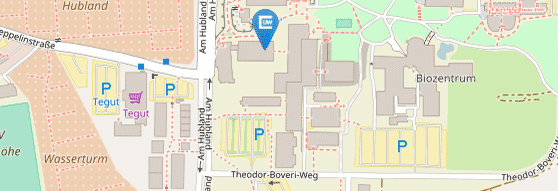Prof. S. G. Srivatsan: "Probing nucleic acid structure and function using functionalized nucleoside toolbox"
| Datum: | 30.06.2023, 16:00 - 17:30 Uhr |
| Kategorie: | Vortrag |
| Ort: | Hubland Süd, Geb. C1 (Neubau f. Organische Chemie), Seminarraum 00.029/030 |
| Veranstalter: | Universität Würzburg, Prof. Dr. Claudia Höbartner |
Organisch Chemisches Kolloquium
Das Institut für Organische Chemie lädt ein zum Vortrag von
Seergazhi G. Srivatsan, Indian Institute of Science Education and Research, Pune, India
mit dem Titel:
"Probing nucleic acid structure and function using functionalized nucleoside toolbox"
Abstract:
Numerous biophysical tools have provided efficient systems to study nucleic acids. However, our current understanding on how nucleic acid structure complements its function, particularly in cellular environment, is limited. This general limitation is largely due to the lack of probes that can be used in both cell-free and cellular assays, and in more than one biophysical technique. Hence, correlating the information obtained under equilibrium conditions, in solid state and in cells becomes very difficult using uniquely-labeled oligonucleotide sequences. In this context, moving away from the tradition approach of “one label one technique” we adopted an innovative approach to investigate the nucleic acid structure and function in cell-free and cellular environments by using conformation-sensitive multifunctional nucleoside analog probes. Based on this strategy, we developed nucleoside analogs equipped with two or more labels (eg., fluorophore, NMR isotope label and X-ray crystallography phasing atom), which serve as common probes for analyzing nucleic acid motifs simultaneously by using a combination of fluorescence, NMR and X-ray crystallography techniques.1-5 In parallel, we also develop chemo-enzymatic labeling technologies to functionalize and image nucleic acids in vitro and live cells.6,7 In this presentation, I will discuss the utility of our nucleoside probes and clickable nucleoside analogs in investigating nucleic acid conformations, recognition and function.
References and notes:
1. Nuthanakanti, A.; Boerneke, M. A.; Hermann, T.; Srivatsan S. G. Angew. Chem. Int. Ed. 2017, 56, 2640–2644.
2. Manna, S.; Sarkar, D.; Srivatsan, S. G. J. Am. Chem. Soc. 2018, 140, 12622–12633.
3. Ashok, N.; Ishtiyaq, A.; Saddam, Y. K.; Kayarat, S.; Srivatsan, S. G. Nucl. Acid. Res. 2019, 47, 6059–6072.
4. Ghosh, P.; Kropp, H. M.; Betz, K.; Ludmann, S.; Diederichs, K.; Marx, A.; Srivatsan S. G. J. Am. Chem. Soc. 2022, 144, 10556–10569.
5. Khatik, S. Y.; Sudhakar, S.; Mishra, S.; Kalia, J.; Pradeepkumar. P. I.; Srivatsan, S. G. Chem. Sci. 2023, 14, 5627-5637.
6. Sawant, A. A.; Tanpure, A. A.; Mukherjee, P. P.; Athavale, S.; Kelkar, A.; Galande, S.; Srivatsan, S. G. Nucl. Acid. Res. 2016, 44, e16.
7. George, J. T.; Mohd. Azhar; Aich, M.; Sinha, D.; Ambi, U. B.; Maiti, S.; Chakraborty, D.; Srivatsan, S. G. J. Am. Chem. Soc. 2020, 142, 13954−13965.


